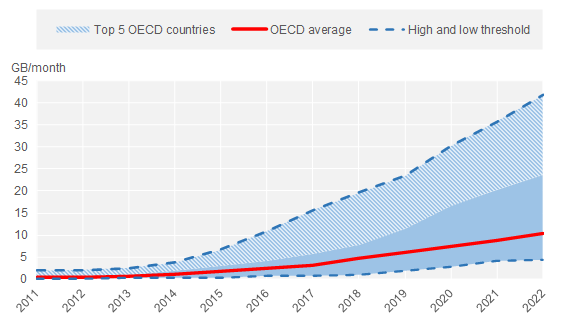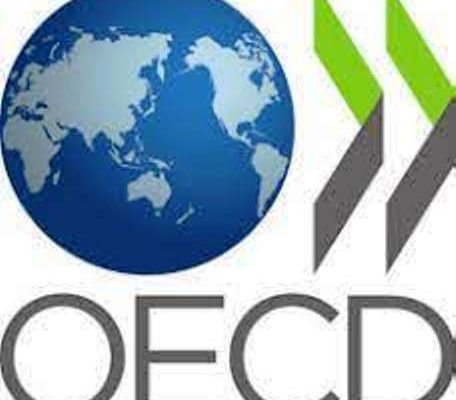Mobile data usage continues to grow, but at a slower pace, according to new OECD broadband portal data released on 13 July. Data usage per mobile broadband subscription in OECD countries grew 17% in 2022, compared to an average annual growth rate of 29% between 2017 and 2021. Nonetheless, the volume of mobile data usage overall per subscription has doubled in four years, from 4.7 gigabytes per month to 10.4 GB in 2022.
RELATED: Fibre is now the dominant broadband access technology in half of all OECD countries
The Organisation for Economic Co-operation and Development (OECD) consist of 38 members countries drawn from Europe, Asia, Middle East and the Americas.
Of note is the range of mobile data consumption volumes registered across OECD countries, spanning from 4.3 GB per user per month to 42 GB – a 10-fold difference between the lowest and highest volumes observed. The five countries with the highest data usage levels – Latvia (42 GB per month), Finland (40 GB), Austria (30 GB), Lithuania (28 GB) and Iceland (24 GB) – consume three times more data than the OECD average. This gap, between the leading countries and the OECD average, has continued to widen year on year.
Range of mobile data usage per month in OECD countries, 2022

In the fixed broadband segment, fibre is now firmly established as the leading connection technology, accounting for 38% of all fixed subscriptions at the end of 2022, up from 28% in December 2019, shortly before the start of the COVID-19 pandemic.
Belgium, Costa Rica, Austria and Israel increased their fibre connections by more than 40% in 2022. Fibre as a share of all fixed broadband now exceeds 80% in Iceland, Japan, Korea, Spain and Sweden, and is greater than 50% in a further 10 OECD countries (Chile, Finland, France, Latvia, Lithuania, Luxembourg, New Zealand, Norway, Portugal and Slovenia). By contrast, the DSL share of total fixed subscriptions has continued to fall, from 40% five years ago to 24% today, while cable has maintained a steady share over the last five years of around 33%.
Overall, fixed broadband subscriptions are still growing in almost all OECD countries, reaching a total of 481.6 million in December 2022 and averaging 35 subscriptions per 100 inhabitants. This compares to 433 million at the end of 2019 – an increase of 48.6 million, or 11.2%, in three years. Switzerland had the highest penetration rate of 48 subscriptions per 100 people, followed by France (47), Norway (46) and Korea (45).
Mobile broadband subscriptions also continue to expand, despite very high penetration rates, growing by 13% between 2019 and 2022. Total subscriptions reached 1.76 billion in December 2022, up from 1.56 billion three years earlier. Estonia and Japan top the ranking for mobile broadband penetration, with 204 and 197 subscriptions per 100 inhabitants, respectively. The United States and Finland, with 176 and 160, respectively, are not far behind.
The rollout of 5G continues apace. As of July 2023, it was available in 37 out of 38 OECD countries. For the 20 OECD countries able to provide relevant data, the share of 5G in total mobile broadband subscriptions averaged 21%, with the highest share in Denmark (54%), Korea (45%) and Japan (26%).
Machine-to-machine (M2M) SIM cards are once again experiencing the highest growth rates of all indicators, with a 14% increase in one year. The two leading countries are Sweden (222 M2M SIM cards per 100 inhabitants) and Iceland (191), followed by Austria (128), the Netherlands (86) and Norway (72). The issuing and registration of M2M SIM cards by national operators for international usage in Sweden and Iceland accounts for their elevated numbers.
Download broadband data, charts and penetration maps by country at http://oe.cd/broadband.






























